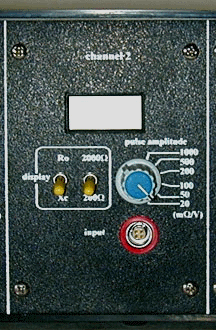UFI Model 2994D THRIM™
Tetra-polar High Resolution Impedance Meter
The 2994D THRIM is a Tetra-polar High Resolution Impedance Measurement device, designed for use with human subjects. Subject connection is via electrodes placed on the skin.
A single, crystal controlled, constant current "Excitation" generation block supplies the necessary drive signal, and also synchronizes the overall demodulation process for individual channels.
Multiple "Demodulation" or measurement channels sense and supply 4 specific Impedance values (Ro, Xc, deltaRo, dRo/dt) from each of the up to 4 subject segments located between the two Drive points.
The use of a built-in "3 Port Isolation" scheme enhances subject safety. Power for the 2994D THRIM can be supplied by 6 ea. "C" alkaline batteries, or by the supplied external DC power supply.
2994D THRIM Development
The first steps toward the UFI THRIM™ (Tetra-polar High Resolution Impedance Meter) were for a human-subject centrifuge project, in 1982. This instrument measured impedance in the body to quantify fluid shifts under acceleration.
The THRIM design was expanded into a desk-top, multi-channel impedance instrument in 1985. Using built-in constant-current excitation, this instrument supplied complex impedance (Ro and Xc) as well as pulsatile (deltaR and dR/dt) signal outputs for each channel. A front panel LCD for each channel displayed Ro or Xc using one of two different ranges (0-199 or 0- 1,999). A Pulsatile Size Control adjusted the deltaRo output. This analog-only design supported up to four channels.
UFI redesigned the THRIM in 1998 to use a more stable "digital synthesis" impedance measurement technique. Crystal-locked stability was integral to this revised architecture, which also featured a much-reduced parts count and 9V battery power. Like the 1985 design, the 1998 version featured four outputs for each channel (Ro, Xc, deltaRo and dR/dt) and adjustable pulsatile size control.
We revised the THRIM yet again in 2004, this time for another centrifuge project. In response to numerous customer requests, UFI added subject isolation to all THRIM outputs. An in-line transformer or batteries now supply power, so we have augmented subject isolation with an isolation barrier between the incoming DC power and the rest of the THRIM circuitry.
The plastic case (shown in the picture at top) is also new for 2004, and can be configured for either rack mounting or desk top use. Input connectors are now the robust, easy-to-use Lemo 1B type. The BNC output connectors are still standard, but high density connectors are available as an option.
2994D THRIM specifications
Inputs
- 1, 2, 3, or 4 channels of impedance sensing
- Input impedance: 10 KOhms differential
- Rugged Lemo 1B 4-pin input jacks
Functional details
- Crystal controlled for long-term stability
- 51.2 KHz excitation frequency generator
- 1 mA constant-current drive excitation
- DeltaR gain: 20, 50, 100, 200, 500, and 1,000 milliohms per volt
Outputs
- LCD display of Ro or Xc (switch selectable)
- 0-199 or 0-1999 LCD range (switch selectable)
- Ro, Xc, deltaR, and dR/dt outputs for each channel
- deltaR output time constant: 1 second
- BNC output connectors standard (other connectors available)
Power supply and mechanical
- Provision for either in-line power supply or battery power
- Black ABS plastic rack-mount or desktop case
- Size: 17" x 5.1" x 8" (430mm x 130mm x 205mm)
Options
- Optional built-in 12-bit A-to-D capabilitity with USB link, and PC based Data Collection software
- Optional built-in ECG amplifier
- Optional built-in transducer-based Respiration amplifier
- Additional signal conditioning options are also available

Typical channel controls for a THRIM
Some THRIM distinctives
One of our colleagues, Dr. Les Montgomery, has substantial experience, both with bio-impedance, and with the use of our THRIM. He kindly offered the following list of THRIM distinctives!
- "The basic THRIM is a fixed or constant frequency system similar to those instruments that are used for cardiac output etc. A fixed frequency system allows the researcher to record the changes in the outputs as a function of time thereby providing measures of circulatory blood flow and other parameters such as arterial/venous tone, pulse transit time (when used with the ECG), in addition to the relative changes in segmental volume via the basal resistance values."
- "The THRIM provides the actual Ro values (in addition to Xc). Most other fixed frequency instruments provide the Z value which is a dependent parameter that will vary as Xc changes with intracellular volume changes."
- "You might also mention that UFI has developed custom systems for quite a few environmental uses from +Gz, tourniquets during simulated combat, for use on the Space Shuttle etc. You are (as best as I can tell) the only manufacturer that will customize impedance units for application under very diverse experimental/ operational conditions."
- (UFI has also developed a single channel Electro-Impedance Spectroscopy [EIS] Swept Frequency impedance system, and Dr. Montgomery added these comments about this device.) "You may also want to mention that the EIS will provide information regarding segmental compartment volume rather than hemodynamic measures. HOWEVER - YOUR EIS provides the ability to have the advantages of both types of systems using only one impedance system at any desired sampling periods using the 'scheduler' mode."
THRIM Publications
This is a sampling of recent publications that include THRIM use.
THRIM Instruction Manual
This is a representative Instruction Manual for a THRIM system. Carefully read this manual through if you are thinking about purchasing a THRIM.
